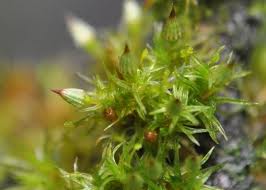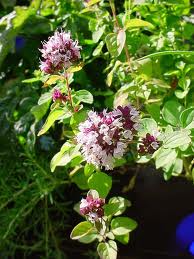Origanum
Some Ornamentals - O. Dictamnus, the Dittany of Crete, is found wild in southern Europe and is grown for its lovely flowers. It can grow up to 12 inches high and has thin, wiry stems, which are clothed in small, fuzzy, oval leaves. Spikes of pink flowers in hop-like heads grow from this plant. O. laevigatum forms a low-growing, spreading mat of small, bluish-green leaves. Arching stems bear tightly packed, tiny, two-lipped flowers ranging from pink to mauve to violet purple. There are numerous crosses and cultivars of O. laevigatum.
Sweet Marjoram (O. majorana) - Also known as Knotted Marjoram or Wurstkraut, this popular herb is from Europe. This half-hardy perennial can be grown as an annual in regions where winters are cold. Sweet Marjoram is a little gray-green plant that will grow up to a foot high if grown as an annual and up to 2 feet high as a perennial. Branches that hang down will take root and grow to form a loose, airy clump. The small, rounded leaves have a unique sweet scent when crushed. They are used as flavoring, in sachets and as a source of oil in perfume. Sweet Marjoram produces unnoticeable white flowers.
Oregano (O. vulgare) - The common Oregano is a perennial that can grow from 12 to 24 inches high and bears purple or pink flowers, which look pretty in dried or fresh arrangements. The leaves, however, have very little flavor. The hybrid "Aurea" has golden leaves. O. onites (Italian Oregano; Pot Marjoram) is a tender perennial with small leaves. The flowering stems grow up to 18 inches high. It has a delicate, warm flavor and is the most popular Oregano for Italian foods. O. heracleoticum (Greek Oregano; Winter Marjoram) has coarse, ovate, fuzzy leaves and grows up to 18 inches high in bloom. It has a strong, earthy fragrance and is the most flavorful. Hardiness varies among the different types, but all are perennial. Spanish Oregano (O. virens) is a half-hardy perennial with a strong flavor. It grows taller than the others and has round, bright apple-green leaves.
Pot Cultivation
The Origanum grown for ornament may be planted outside in a sunny spot in sandy loam. They can also be grown in containers filled with two parts of sandy loam and one part leaf mold, with an abundance of sand added. Shade them from direct sun after potting and withhold water until the soil becomes quite dry. Marjoram should be grown in full sun, in soil that is well drained and limed. Old plants can be divided in autumn and brought in a greenhouse or cold frame during the winter. Marjoram shouldn't be cut too severely. Only take a third of the top growth at a time. The flavor is best when the flower buds begin to appear. Use fresh as a component to fines herbs, or alone to flavor eggs, sausages, stuffings, or vegetables. The leaves dry easily and quickly. All Oreganos grow better in full sun and well-limed, fertile soil that is moist. They will tolerate poor soil and dry conditions, but won't fare as well. To harvest Oregano, shear it halfway back once blooming begins. All Oreganos dry rapidly and maintain their robust flavor; dry the leaves whole and crush just before use.Propagation
Those grown for ornament may be increased by cuttings, which are made from small side shoots in the spring. The lower leaves are removed and a clean cut is made just below the bottom joint. They are then inserted in sand and covered with a bell jar. Wipe the inside of the jar every morning to prevent decay. When they've formed roots they may be potted separately. Marjoram is slow to grow from seeds, so purchase plants. Old plants may be divided. Common and Greek Oreganos grow readily from seeds started inside in late winter. Transplant the seedlings after danger from frost has passed. Italian and Spanish Oreganos should be purchased. Italian Oregano can be propagated from cuttings or by dividing old plants. |
 |
O. pulchellum |
O. heracleoticum |
VARIETIES
- Ornamental -
O. Dictamnus;
O. hybridum;
O. pulchellum;
O. laevigatum & cultivars;
O. herrenhausen.
- Marjoram -
O. majorana
- Oregano -
O. vulgare;
O. onites;
O. heracleoticum;
O. virens;
O. isthmicum.




